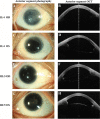A novel 4.25 kb heterozygous deletion in PAX6 in a Chinese Han family with congenital aniridia combined with cataract and nystagmus
- PMID: 34610801
- PMCID: PMC8491394
- DOI: 10.1186/s12886-021-02120-0
A novel 4.25 kb heterozygous deletion in PAX6 in a Chinese Han family with congenital aniridia combined with cataract and nystagmus
Abstract
Background: The aim of this study is to identify the genetic defect in a Chinese family with congenital aniridia combined with cataract and nystagmus.
Methods: Complete ophthalmic examinations, including slit-lamp biomicroscopy, dilated indirect ophthalmoscopy, anterior segment photography, and anterior segment optical coherence tomography (OCT) were performed. Blood samples were collected from all family members and genomic DNA was extracted. Genome sequencing was performed in all family members and Sanger sequencing was used to verify variant breakpoints.
Results: All the thirteen members in this Chinese family, including seven patients and six normal people, were recruited in this study. The ophthalmic examination of affected patients in this family was consistent with congenital aniridia combined with cataract and nystagmus. A novel heterozygous deletion (NC_000011.10:g.31802307_31806556del) containing the 5' region of PAX6 gene was detected that segregated with the disease.
Conclusion: We detected a novel deletion in PAX6 responsible for congenital aniridia in the affected individuals of this Chinese family. The novel 4.25 kb deletion in PAX6 gene of our study would further broaden the genetic defects of PAX6 associated with congenital aniridia.
Keywords: Congenital aniridia; Copy number variant; Deletion; PAX6.
© 2021. The Author(s).
Conflict of interest statement
The authors declare that they have no competing interests.
Figures





References
MeSH terms
Substances
LinkOut - more resources
Full Text Sources
Medical

